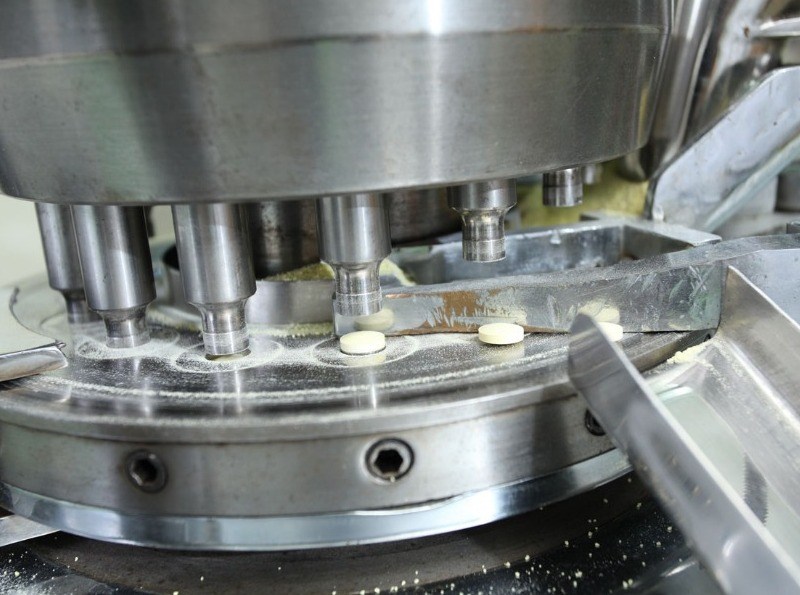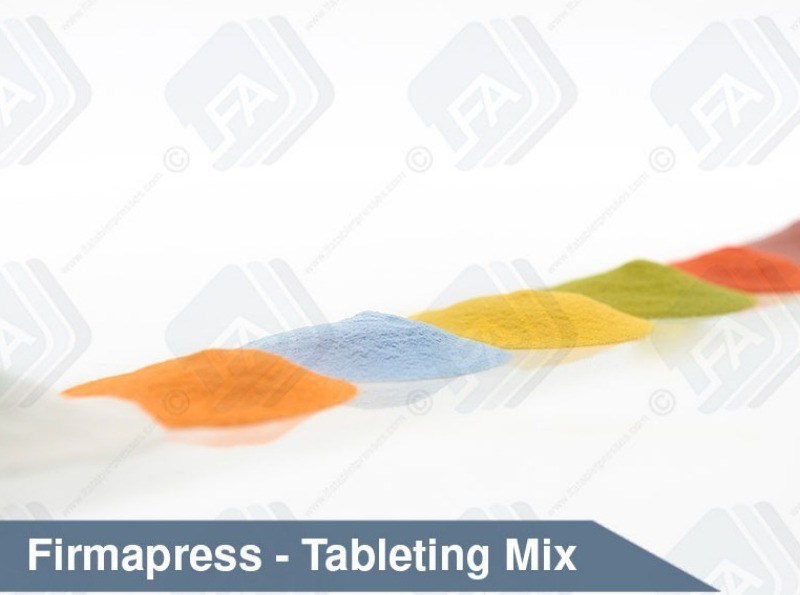The manufacturing of a tablet involves compressing an active pharmaceutical ingredient with several excipients. However, simple compaction of a dry powder between two punches often yields a tablet that crumbles easily.

Granulation Process for Mechanical Strength
Granulation Purpose
-
To produce tablets with sufficient mechanical strength, the raw powder formulation is typically subjected to granulation. This process reduces large powder particles into smaller, more uniform granules.
Wet vs Dry Granulation
-
Wet granulation is generally preferred over dry granulation. It results in finer, more cohesive granules that flow more easily into the dies of tablet presses. Wet granulation requires the use of a liquid and a binding agent. The binding agent facilitates particle adhesion, forming stable granules.
Liquid Selection
Compression Into Tablets
-
Once the granulated mixture is compressed, it forms tablets with adequate hardness to withstand packaging, storage, and transportation.
Binding Agents in Granulation
A wide range of natural and synthetic polymers and sugars are used as binding agents. This article focuses specifically on water-soluble binding agents, which are commonly employed in wet granulation.

In addition to their traditional use, certain polymers are being developed for advanced drug delivery applications. These include:
-
Polymer-drug conjugates (e.g., for insulin, peptides, lipids)
-
Soft gel capsule matrices for insoluble drugs
-
Hydrogels for sustained topical release
The binding agents that are discussed below divided for convenience into two categories:
-
Synthetic water-soluble polymers
-
Natural water-soluble polymers
1. Synthetic Water-soluble Polymers
-
Polyethylene Glycol (PEG)
PEG is synthesized from ethylene glycol and has a low polydispersivity index (PDI), giving it reliable residence times in the body. It is widely used in pharmaceutical formulations due to its favorable properties.
Low Polydispersivity Index (PDI)
High Solubility
Hydrophilic Nature
Functional Uses in Formulation
-
Improves plasticity of other binding agents
-
May prolong tablet disintegration at concentrations higher than ca. 5% by weight
-
Acts as a meltable binder when water or alcohol is unsuitable
Chemical Flexibility
-
Polyvinyl Pyrrolidone (PVP or Povidone)
The most widely used synthetic binding agent, PVP is a water-soluble polymer made by polymerising vinylpyrrolidone in water or propan-2-ol.
Molecular Weight Range
Grades Based on MW
Wet Granulation With PVP (MW 25,000–50,000) Produces:
-
Hard granules
-
Good flowability
-
High binding strength
-
Low friability
Enhances Drug Dissolution
Improves Bioavailability
Other Applications
-
Used in hot melt extrusion to create glass solutions
-
Combined with citric acid trimesters to make soft, clear capsules for insoluble drugs
-
Some grades support sustained release tablet formulations
-
Polyvinyl Alcohol (PVA)
PVA is synthesized by polymerising vinyl acetate and then hydrolyzing it.
Properties Are Affected by
-
Degree of hydrolysis
-
Acetate group content
Solubility
-
Soluble in water, ethylene glycol, and N-methyl pyrrolidone
-
Often used in combination with these solvents
Pharmaceutical Applications
-
Other Synthetic Polymers
Several water-soluble synthetic polymers have been investigated as:
Although not yet widely adopted, these materials show potential for specific oral dosage forms and advanced drug delivery applications.
Examples include:
Polyacrylamides and Polymethacrylamides
Divinyl Ether–maleic Anhydride
Polyoxazoline
Polyphosphates

2. Natural Water-Soluble Polymers
-
Starch
Starch is one of the earliest binding agents used in tablet manufacturing. Its appearance is white, odorless, tasteless powder.
Composed Mainly of
Starch is highly hydrophilic due to abundant hydroxyl groups and is sourced from corn, potato, wheat, and other plants.
Limitations of Native Starch
-
High viscosity
-
Poor flowability
-
Prone to agglomeration
-
Inconsistent performance
Freshly prepared starch is now rarely used in modern formulations without modification as a binding agent.
-
Pre-Gelatinized Starch
Modified starch offers improved properties for pharmaceutical use. Produced by hydrolysis and drying of maize, potato, or rice starch. Starch may also undergo hydroxypropylation to:
Typical Composition
-
5% free amylose
-
15% free amylopectin
-
80% unmodified starch
Applications
Used as:
Common Concentrations
-
Liquid Glucose
Source
Appearance
Functional Properties
Pharmaceutical Use
-
Cellulose Ethers
Key Benefits
Limitations
Common Water-Soluble Cellulose Derivatives
-
Hydroxypropylmethyl cellulose (HPMC)
-
Hydroxypropyl cellulose (HPC)
-
Hydroxyethyl cellulose (HEC)
-
Sodium carboxymethyl cellulose (Na-CMC)
Uses of These Cellulose Ethers

-
Carnauba Wax
Carnauba wax is a safe, inert, and non-toxic plant which can be found in many other industries than the pharmaceutical industry (e.g. car wax, dental floss).
Source
Known As
-
Carnauba wax
-
Palm wax
-
Brazilian wax
Main Component
Used For
-
Guar Gum
Natural polysaccharide obtained from the endosperm of the guar plant. The swelling ability of guar gum is used to delay the release of drugs from oral dosage forms.
Used As

-
Pectin
Mixture of polysaccharides from citrus peel or apple pomace, both of which are byproducts of juice production.
Applications
-
Additive in convenience foods
-
Binder in tablets (often combined with HPMC)
-
Matrix for drug, protein, or cell entrapment/delivery
Additional Functional Benefits
-
Xanthan Gum
-
Free-flowing powder
-
Soluble in hot and cold water
-
Forms a viscous solution at low concentrations
-
Commonly used in controlled-release and suspension formulations










